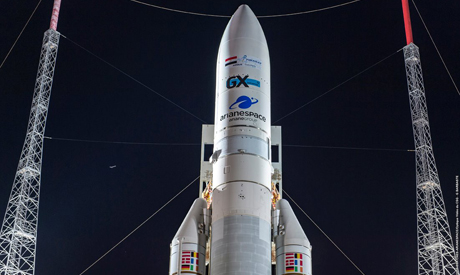
Tiba 1 (photo courtesy of Arianespace)
Tiba 1, a communication satellite that will boost coverage not just across Egypt but in some neighbouring African and Arab countries, uses the Ka band, a portion of the microwave segment of the electromagnetic spectrum — ie frequencies in the range of 26.5-40 gigahertz.
The launch of Ariane 5 Flight VA 250, which is carrying Egypt’s Tiba 1 and the UK’s Inmarsat GX5 satellites, was postponed on Monday night for the fourth time in four days. This time, according to an official at Arianespace, the delay was due to unfavourable weather conditions at the airbase in French Guiana.
Mohamed El Koosy, executive director of the Egyptian Space Agency (ESA), told Al-Ahram Weekly the next launch window was Tuesday, 26 November 2019, at 11:09pm.
“The launch will go ahead if technicians at the base judge all systems in order and the weather conditions are favourable,” he said. Tiba 1 was launched at 11:35pm, minutes before the Weekly went to press.
According to Thales Alenia Space Italia, which developed Tiba 1, the satellite has a 15-year working life. After NileSat 101 (1998), NileSat 102 (2000) and NileSat 201 (2008), it will be the fourth Egyptian satellite carried into orbit by Arianespace. Airbus Defence and Space supplied the launching platform and handled the assembly and testing of the spacecraft.
The satellite will offer an opportunity for Egypt to begin selling satellite communication services.

The satellite’s launch into space was originally scheduled for Friday, 22 November, at 11pm and was delayed when a malfunction in the ground segment power supply to the launching pad occurred minutes before take-off. The launch was then postponed for 48 hours. Arianespace Executive Director Stephane Israel appealed to observers and stakeholders to remain patient.
Tiba 1 is far from being Egypt’s first foray into communication satellites. Private sector firms led the way with communication and remote sensing satellites, including CubeSat satellites which are used at low altitudes, one of which the ESA launched earlier this month. Weighing around one kilogramme, it was put into orbit by the Japanese Space Systems Corporation. The tiny CubeSat was entirely manufactured at the ESA.
The ESA is a public authority under the supervision of the presidency. Established in 2018, it aims to upgrade Egypt’s aerospace programme and promote the transfer of aerospace technology in order to enable Egypt to become self-sufficient in the manufacture of satellites.
El Koosy said that the signals and images relayed by the new CubeSat will be received at the Egyptian Space Agency and used for a variety of agricultural, geological and other purposes.
The Ariane 5’s other payload, the Inmarsat GX5, will serve Europe and the Middle East, and provide WiFi services on board aeroplanes and ships. It uses the 72Ka band and will be able to offer services at significantly higher capacities than its predecessors, according to officials at Arianespace.
Ariane 5’s flight number, VA250, indicates that it is the 250th mission powered by Ariane missiles. The first launch took place on 24 December 1979. The first successful launch of the Ariane 5 series occurred on 21 October 1998 after a complete failure in 1996 and a partial failure in 1997.
The first successful launch of an Ariane 5 ECA took place on 12 February 2005. There have been 69 successful missions since then of the rocket which is designed to carry a payload of up to 10 tons.
*A version of this article appears in print in the 28 November, 2019 edition of Al-Ahram Weekly.
Short link: